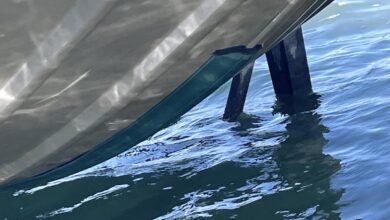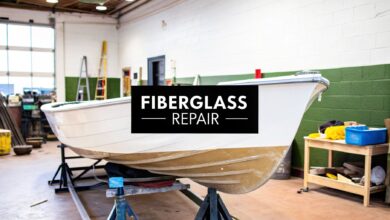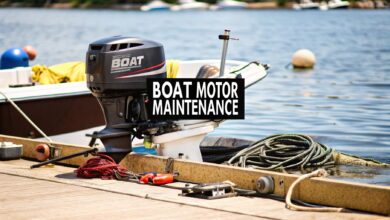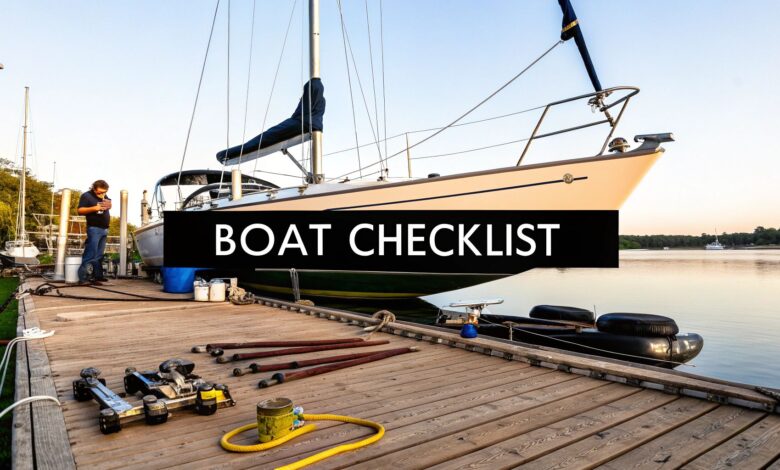
Owning a boat offers unparalleled freedom, but it requires regular upkeep. A well-maintained vessel is safer, more reliable, and holds its value. Forgetting a task can lead to costly repairs or dangerous situations far from shore.
Creating a comprehensive boat maintenance checklist is the best way to stay ahead of problems. It turns boat care into manageable, scheduled tasks. This guide provides a clear framework covering everything from the engine to safety gear.
This listicle is your definitive resource, whether you are a new or seasoned owner. We will break down essential tasks by frequency: before each trip, monthly, and annually. Following these steps protects your investment and ensures every voyage is safe.
1. Engine Oil and Filter Change
Regular engine oil and filter changes are the most critical task on any boat maintenance checklist. Marine engines operate under heavy loads in corrosive saltwater environments. These conditions accelerate oil breakdown, reducing its ability to protect vital components.
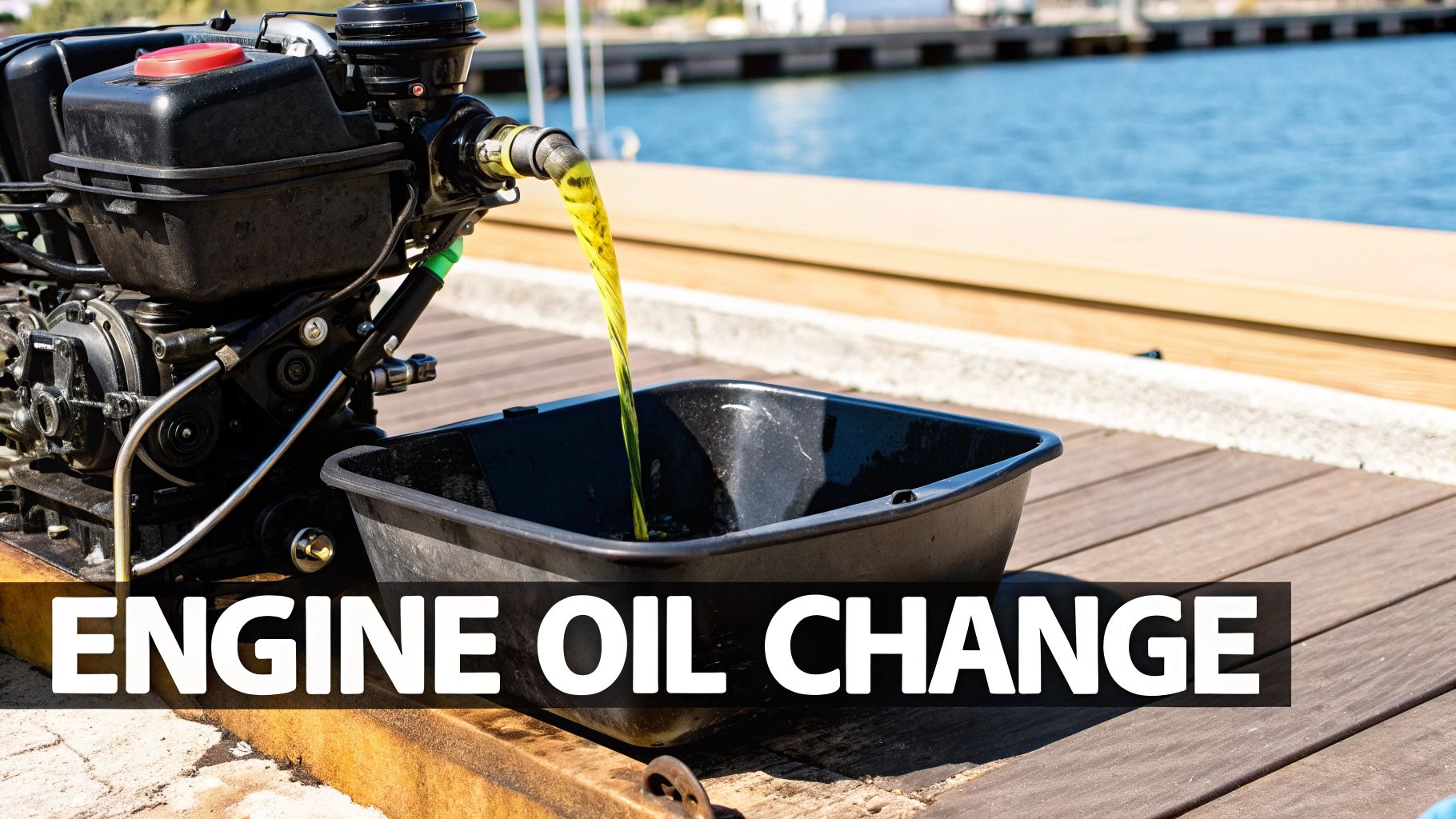
Neglecting this task leads to increased friction, overheating, and premature wear. This can result in catastrophic engine failure and expensive repairs. A consistent schedule is key to your engine’s longevity and reliability.
Why It's Critical and When to Do It
Engine oil minimizes wear on moving parts and helps dissipate heat. Over time, oil becomes saturated with contaminants, and its protective additives deplete. This is why manufacturers provide specific service intervals that must be followed.
Common Service Intervals:
- Outboard Engines (e.g., Yamaha, Mercury): Change oil and filter every 100 hours or annually, whichever comes first.
- Inboard/Sterndrive Engines (e.g., MerCruiser, Volvo Penta): Also follow a 100-hour or annual schedule, often using marine-grade oil like 25W-40.
- Marine Diesel Engines (e.g., Caterpillar, Cummins): Have longer intervals, usually between 250 and 500 hours.
Key Insight: Always consult your engine’s service manual for the exact oil type and interval. Using non-marine oil can void your warranty as it lacks necessary anti-corrosion additives.
How to Perform an Engine Oil Change
Changing your boat's oil is a straightforward process many owners can do themselves. The right tools, like an oil extraction pump and filter wrench, make the job cleaner. This visual guide is a great starting point for those new to the process.
Actionable Tips for a Flawless Oil Change:
- Warm Up the Engine: Run the engine for 5-10 minutes to warm the oil. Warm oil drains more completely, taking more contaminants with it.
- Always Replace the Filter: Never reuse an old oil filter. Lightly coat the new filter's rubber gasket with new oil before installing it to ensure a good seal.
- Keep Meticulous Records: Log the date, engine hours, and products used for every oil change. This log is invaluable for tracking maintenance history and preserving your warranty.
2. Hull Cleaning and Antifouling
A clean hull is vital for a boat's performance, fuel economy, and integrity. Regular cleaning removes marine growth like algae and barnacles. A layer of antifouling paint prevents these organisms from attaching in the first place.
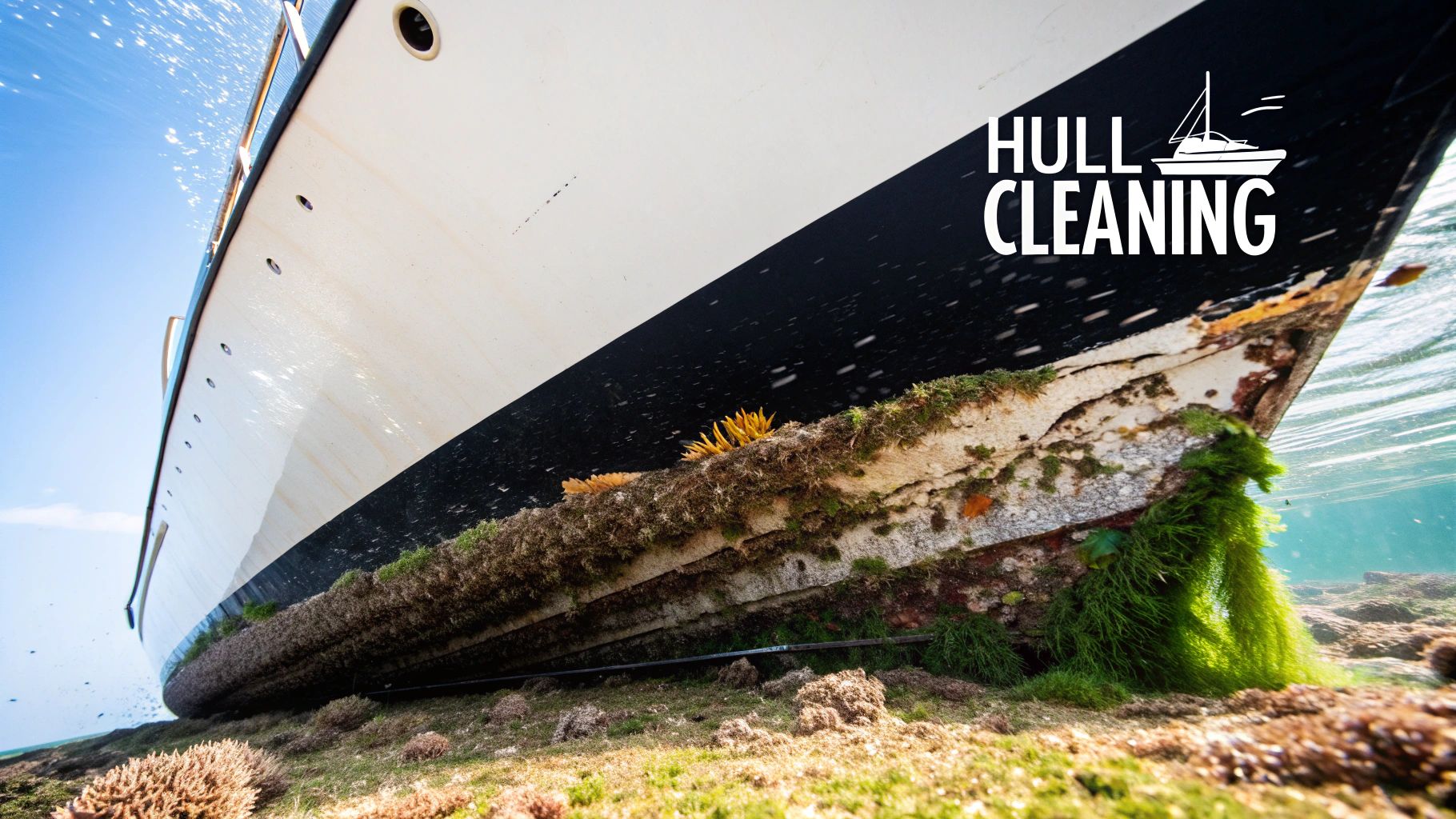
Neglecting the hull creates drag, forcing your engine to work harder and burn more fuel. It can lead to a drop in speed and long-term damage like blistering. A smooth, clean underwater surface ensures your vessel operates efficiently.
Why It's Critical and When to Do It
Antifouling paint works by slowly releasing biocides that deter marine life. This protective barrier wears down over time and needs replenishment. The frequency of cleaning and repainting depends on water conditions and usage.
Common Service Intervals:
- Saltwater Cleaning: In warm saltwater, monthly underwater cleanings are often necessary to manage growth.
- Freshwater Cleaning: Growth is slower in freshwater, so cleaning may only be needed a few times per season.
- Antifouling Paint Application: Most boats require a new coat of antifouling paint annually.
Key Insight: The type of antifouling paint must match your boat's usage and home waters. Ablative paints are ideal for boats used regularly, while hard paints are better for trailered vessels.
How to Maintain Your Hull
While a boatyard often applies antifouling paint, owners can do regular in-water cleanings. Use soft-bristle brushes or non-abrasive pads to avoid scrubbing off the paint. This gentle cleaning is key to preserving the coating.
Actionable Tips for Flawless Hull Maintenance:
- Choose the Right Paint: Consult with manufacturers like Interlux or Pettit to select a compatible paint. Ensure it meets local environmental regulations.
- Clean Gently and Regularly: Frequent, gentle cleanings are better than infrequent, aggressive scrubbing. This extends the life of your antifouling coating.
- Inspect While Cleaning: Use cleaning sessions to inspect the hull, running gear, and anodes. Look for signs of damage, blistering, or excessive anode wear.
3. Battery Maintenance and Electrical System Check
A reliable electrical system powers everything from engine ignition to navigation aids. Marine electrical systems are under constant assault from vibration and moisture. Proactive checks prevent sudden power loss that can leave you stranded.
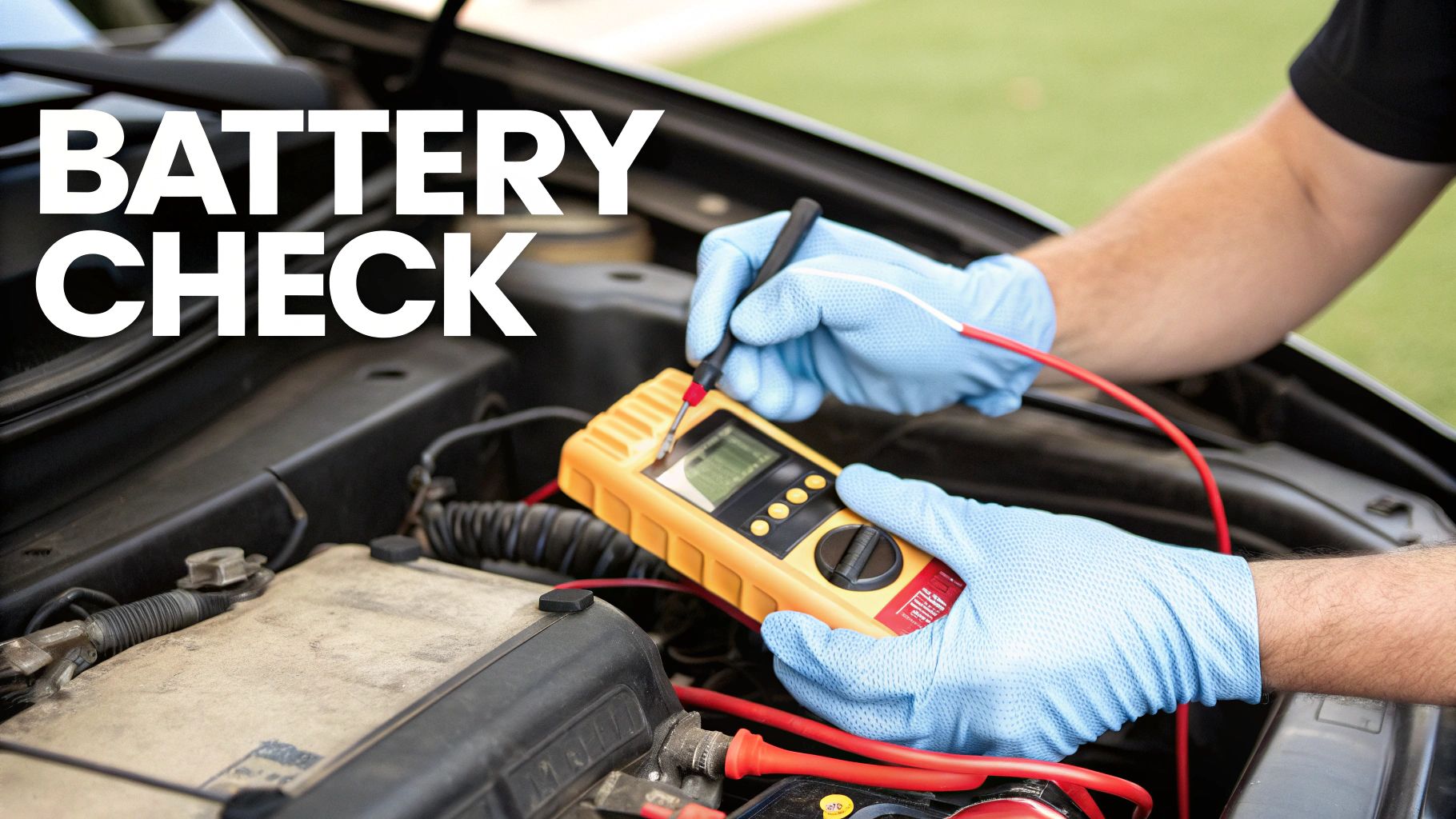
Neglecting your boat's electrical heart can lead to dangerous situations. A dead engine or failed navigation lights are serious risks. Consistent inspection ensures all components work as intended when you need them most.
Why It's Critical and When to Do It
Your boat's batteries provide crucial cranking amps for startup. The corrosive marine environment can degrade terminals and wires, leading to failure. Regular checks prevent these issues from becoming major problems.
Common Service Intervals:
- Monthly Checks: Visually inspect battery terminals for corrosion and ensure connections are tight.
- Pre-Departure Checks: Test battery voltage and confirm electronics are working before leaving the dock.
- Seasonal/Annual Checks: Perform a load test on all batteries and thoroughly clean all connections.
Key Insight: A simple voltage reading isn't enough to determine a battery's health. A battery can show a full charge but fail under load. A proper load test is the only way to assess its true condition.
How to Perform an Electrical System Check
Maintaining your boat’s electrical system is a task most owners can handle. It involves simple visual inspections, cleaning, and basic testing. Keeping components in top shape ensures reliable performance.
Actionable Tips for a Flawless Electrical Check:
- Clean Terminals Thoroughly: Disconnect the cables and clean any corrosion with a wire brush and a baking soda solution. Rinse, dry, and reconnect.
- Apply a Protective Coating: After cleaning, apply a thin layer of dielectric grease or a marine corrosion inhibitor. This barrier prevents future corrosion.
- Inspect All Wires and Connections: Trace wiring runs, checking for chafe, cracked insulation, or loose connections. Secure loose wires to prevent vibration damage.
4. Propeller Inspection and Maintenance
The propeller is your boat's crucial link to the water, converting engine power into thrust. Regular inspection directly impacts performance, fuel economy, and the drive system's health. A damaged prop can cause vibration and strain your engine.

Even minor nicks or dents can reduce efficiency and speed. A small ding can create vibrations that wear out bearings and seals over time. Making propeller checks a routine habit helps you catch these issues early.
Why It's Critical and When to Do It
Your propeller is vulnerable to impacts with submerged objects like logs or rocks. Fishing line can also wrap around the shaft and destroy vital seals. This can allow water into the lower unit, leading to catastrophic gear failure.
Common Service Intervals:
- Visual Inspection: Perform a quick check before every outing and a thorough one monthly.
- Debris Removal: Immediately remove any visible fishing line or rope wrapped around the hub.
- Professional Repair: Take your propeller to a specialist if you notice dings, bent blades, or vibrations.
Key Insight: Even a minor imbalance can cause vibrations that harm your drivetrain. If you notice a new vibration, have the propeller professionally inspected, even if no damage is visible.
How to Perform a Propeller Inspection
A proper inspection is quick and requires no special tools. Tilt your motor up to get a clear view of the propeller and shaft area. This is an essential task for all types of boats.
Actionable Tips for a Flawless Propeller Check:
- Check for Dings and Dents: Carefully run your fingers along the edge of each blade. Small nicks can be filed smooth, but significant damage requires professional attention.
- Inspect the Hub and Shaft: Look closely for any fishing line wrapped around the base of the propeller. Use pliers to carefully remove anything you find.
- Carry a Spare: For long trips, carrying a spare propeller and the necessary tools is a wise precaution. It can save your trip from ending prematurely.
5. Cooling System Maintenance
A boat's cooling system is the engine's primary defense against overheating. Marine engines are enclosed in a hot space and rely on water to dissipate heat. Proper cooling system maintenance is a vital part of any boat maintenance checklist.
Neglecting this system invites catastrophic failure. A clogged intake or failed water pump impeller can quickly lead to a seized engine. This leaves you stranded and facing a massive repair bill.
Why It's Critical and When to Do It
The cooling system maintains the engine's optimal operating temperature. Raw water systems circulate outside water through the engine. Closed-loop systems use a marine-specific antifreeze cooled by raw water in a heat exchanger.
Common Service Intervals:
- Raw Water Impeller: Replace annually or every 100-300 hours.
- Hoses and Clamps: Inspect before every outing for cracks, swelling, or corrosion.
- Closed System Coolant: Test annually and replace every 2-5 years.
- Thermostat: Test during spring commissioning to ensure it works correctly.
Key Insight: After every use in saltwater, flush the cooling system with fresh water for 5-10 minutes. This simple step is the most effective way to prevent salt buildup and corrosion.
How to Perform Cooling System Maintenance
Key tasks like impeller replacement are within reach of most boat owners. Having the right impeller puller and hose clamp driver makes the job smoother. This video demonstrates the critical process of changing a water pump impeller.
Actionable Tips for a Healthy Cooling System:
- Prioritize the Impeller: The rubber impeller is a wear item designed to fail before more expensive parts. A broken impeller can send fragments throughout the cooling passages, causing blockages.
- Use Marine-Specific Antifreeze: In closed-loop systems, never use automotive antifreeze. Marine-grade antifreeze contains specific additives to protect against corrosion.
- Inspect Sacrificial Anodes: Many cooling systems have internal sacrificial anodes (zincs). Check and replace these annually to prevent galvanic corrosion.
6. Fuel System Inspection and Cleaning
A clean fuel system is the lifeline of your boat's engine. Marine fuel systems are exposed to humid air, which promotes water contamination. Ethanol-blended fuels can absorb water and deteriorate fuel lines, leading to clogs.
Neglecting the fuel system is a common cause of on-water breakdowns. Contaminated fuel can clog injectors, while degraded fuel lines can leak, creating a fire hazard. Diligent maintenance ensures a reliable fuel supply and your safety.
Why It's Critical and When to Do It
Your boat’s fuel system delivers a clean, consistent flow of fuel to the engine. Water, sediment, and ethanol can quickly compromise its integrity. Water accumulation leads to microbial growth and corrosion.
Common Service Intervals:
- Fuel Filters: Replace annually or every 100 hours.
- Fuel/Water Separator: Inspect the bowl before every outing and drain it when water is visible.
- Fuel Lines and Hoses: Inspect for cracks or brittleness at the beginning of each season.
- Fuel Stabilizer: Add a marine-specific stabilizer to the tank every time you fill up.
Key Insight: Keep your fuel tank as full as possible during storage. A full tank minimizes the air space where condensation can form, reducing the risk of water in your fuel.
How to Perform a Fuel System Inspection
A thorough check involves tracing the fuel's path from the tank to the engine. Look for signs of wear, contamination, or potential failure. Installing a quality fuel/water separating filter is one of the best upgrades you can make.
Actionable Tips for a Healthy Fuel System:
- Check Hoses and Clamps: Squeeze the fuel lines; if they feel mushy or brittle, replace them. Ensure all hose clamps are tight and free of corrosion.
- Inspect the Fuel/Water Separator: Regularly drain the collection bowl into a clear jar. If you see water, investigate the source of contamination.
- Smell the Fuel: Fresh fuel has a distinct smell. If it smells sour, it may be old and need to be replaced.
7. Safety Equipment Inspection
A rigorous inspection of your safety equipment is a crucial part of any boat maintenance checklist. This task is about compliance and being prepared for the unexpected. Functioning safety gear can turn a crisis into a manageable situation.
Neglecting this area can have severe consequences, from fines to tragic outcomes. A systematic check ensures you are ready to respond to a fire or medical emergency. It is fundamental to safe boating.
Why It's Critical and When to Do It
Safety equipment is your lifeline when things go wrong. Life jackets, flares, and fire extinguishers have a limited service life. Regular checks ensure they will work when you need them most.
Common Service Intervals:
- Before Every Trip: A quick visual check of life jackets, throwables, and fire extinguisher gauges is essential.
- Monthly: Test electronic safety devices like your VHF radio and horn.
- Annually: Conduct a thorough inventory and check the expiration dates on all flares and fire extinguishers.
Key Insight: Create a log of your safety gear with model numbers and expiration dates. Set calendar reminders for critical replacement dates, such as for flares and EPIRB batteries.
How to Perform a Safety Equipment Inspection
A methodical inspection is fast and effective. You must physically handle and examine each piece of equipment to verify its condition. Make sure all gear is easily accessible.
Actionable Tips for a Flawless Safety Check:
- Check Life Jackets Thoroughly: For inflatable PFDs, open them up to inspect the CO2 cylinder. For foam vests, check for rips, tears, and deteriorating straps.
- Verify Fire Extinguisher Readiness: Ensure all fire extinguishers are in the green zone on the pressure gauge. Shake them to prevent the powder from compacting.
- Manage Flare Expiration: Flares are dated and must be replaced before they expire. Keep expired flares as backups, but ensure your primary set is accessible.
Making Maintenance a Routine for Worry-Free Boating
Successful boat ownership requires a commitment to proactive care. This guide has broken down the essential tasks for any effective boat maintenance checklist. Each component demands regular, scheduled attention for a safe and reliable vessel.
Consistent maintenance is about reliability and safety. A well-maintained boat starts when you turn the key and handles as expected. It ensures all safety systems are ready when you need them most.
From Checklist to Habit: The Power of Proactive Care
The goal is to transform this checklist into an ingrained routine. Think of it as a continuous cycle of care that protects your investment. This builds a deeper understanding of your vessel's needs.
Consider these key takeaways from our checklist:
- Frequency is Key: Differentiating between daily, monthly, and seasonal tasks is crucial.
- System Interconnectivity: A problem in one area can impact another, highlighting why a holistic approach is important.
- Documentation is Your Friend: A detailed log helps you stay on schedule and is an asset for troubleshooting.
Your Action Plan for Seaworthy Confidence
Mastering boat maintenance is an ongoing journey. The knowledge you gain empowers you to be a more confident operator. It replaces anxiety with the assurance that your vessel is in prime condition.
The greatest benefit is peace of mind. It’s the freedom to head for the horizon, knowing you’ve ensured a safe adventure. Your boat is a gateway to memories, so treat it with consistent, thoughtful care.
This proactive mindset defines a true boater. By embracing a regular boat maintenance checklist, you cultivate a culture of safety. This will serve you well on every voyage.
Ready to dive deeper into specific maintenance procedures or explore advanced topics? The Boating Articles library is your ultimate resource for expert guides, detailed tutorials, and insights that go beyond the basics. Visit Boating Articles to expand your knowledge and become a more confident, skilled boat owner.

